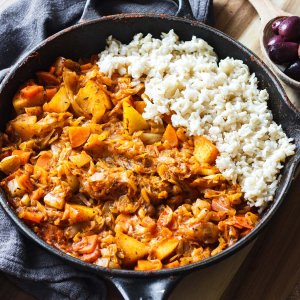
Traditional Sour Cabbage Stew (Vegan)
Servings: 4 big servings
Print RecipeCheap, delicious and nutritious, this sour cabbage stew is one of those traditional recipes found in all Eastern European cuisines. Absolutely and easy to make, this sour cabbage stew comes with a special sweet, sour and salty taste that you won’t find anywhere else.
Equipment
- Skillet or Cooking Pot
Ingredients
Sour Cabbage
- 1/2 medium sour cabbage (about 500 g, alternatively use fresh white cabbage)
- 3 shallots (peeled and sliced)
- 1 big slice fennel (chopped)
- 3 carrots (cubed)
- 1 slice medium celery root (1/3 cup, peeled and cubed)
- 1 big tbsp extra virgin coconut oil (or 2-3 tbsp of extra virgin olive oil)
- 1 big apple (no seeds, sliced)
- 2 tsp dried thyme
- 2 tsp dried dill
- a few basil leaves (optional)
- 3 cloves garlic (chopped)
- 1-2 tsp Himalayan salt
- 1-2 tsp white or black pepper
- 2 tsp sweet paprika (or 4 tsp tomato paste 22%)
- water (as needed)
Rice
- 125 g Basmati rice (or Jasmin rice)
- water (as needed)
- 1 tsp Himalayan salt
Instructions
How to Cook the Cabbage
- Chop the cabbage (not very fine) and add it to a cast iron pan or a big pot.
- Prepare all the other vegetables as indicated in the parentheses and add them into the same cooking pot.
- Also add extra virgin coconut oil (or extra virgin olive oil).
- You can add the apple now or you can add it later, towards the end of the cooking process.
- Cook over medium heat, making sure to add more water if needed. Mix from time to time using a spatula, making sure the cabbage won’t stick to the skillet (this is important!).
- Once the cabbage starts to reduce in size and becomes soft, add spices and salt. Now it’s a good time to add either sweet paprika or tomato paste. Incorporate them slowly using a spatula.
- If you haven’t added the apple slices yet, this is the time to throw it in.
- Cook a for a few more minutes just to make sure that most of the water has evaporated. Taste the cabbage to see if it’s cooked-soft and that it has enough salt.
- Ta-Daa! Your cabbage stew is ready now. Serve with your favorite extras and enjoy the traditional Easter-European aromas.
How to Cook the Rice
- Add rice to a pot and cover with water.
- Cook on small to medium heat until the rice expands. Do not boil the water as that is not a smart way to cook rice.
- Use a wooden spatula to mix the rice from time to time, making sure it won’t stick to the pot. Add more water if needed and supervise the cooking process (won’t take more than 20 minutes).
- Once the rice expands, taste it to make sure that it’s almost done. If not, continue to simmer on medium heat (do not boil the water).
- You’ll notice that the water will start to become less and less, which means the rice expands more and more.
- When the rice is cooked (taste it first to be sure) remove from heat and set aside for a minute.
- Add salt and incorporate using a spatula.
- Leave it covered for a minute to allow the rice to finish absorbing the water, which in turn will make it more tender and soft.
- Strain the water and … That Is It !
Notes
How to make your own sour cabbage? Take a few whole white cabbage heads, wash them and cut them in half. In a big white jar, add the cabbage and fill with water almost to the top. Add salt (about 25g per kilogram of cabbage) and cover the jar. Place in a cold place (but not a fridge) for 2-3 weeks or more. Bacteria will soon develop in the water and will essentially ferment the cabbage.
In case you don’t have access to whole sour cabbage, you can also make this stew using sweet cabbage. In this case you’ll have to compensate for the lack of a sour taste. My suggestion would be to add the juice from 1/2 lemon or 1 lime towards the end of the cooking process.
You can serve this sour cabbage stew with one or more sources of healthy fats. My favorites are: olives, walnuts and pecans, sour cream, hard and soft cheeses.
When it comes to cooking, this recipe is so versatile and forgiving that we don’t have to measure everything to the gram. in fact, my suggestion is to taste it while it’s cooking and to use your taste buds (and intuition) as a guide to cooking the stew that you want to eat.